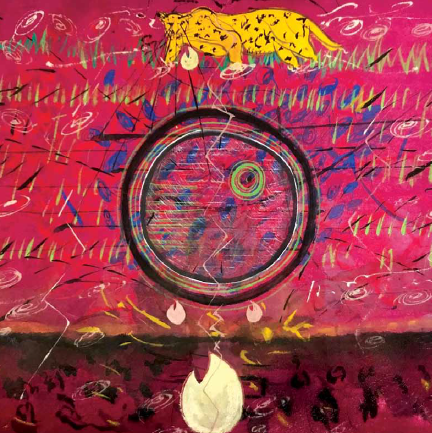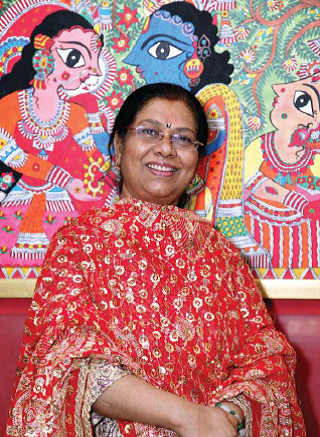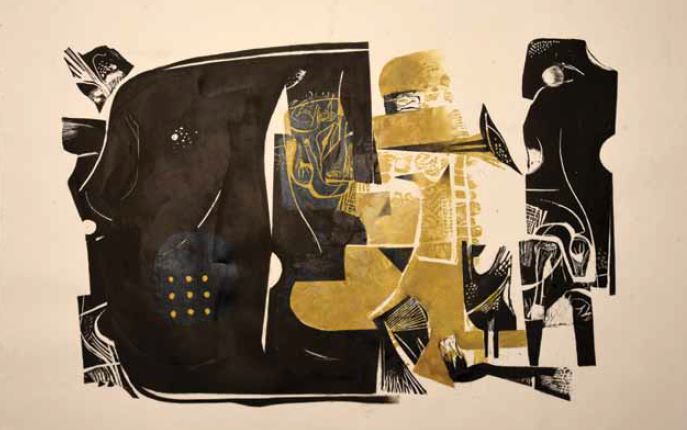
Not one to love labels, Shyam Sharma’s art withstands any and all boundaries. However, his fascination with life and its correlation with nature is consistent in all his pieces, says Neelam Gupta
From being a student of painting to later becoming a reputed teacher of printmaking, Padma Shri Shyam Sundar Sharma’s journey as an artist is inspiring and commendable. As one of the finest and pioneering printmakers in India, the 81-year-old who lives and practices art in Patna, has been known within printmaking and educational circles for decades, but his extraordinary output still awaits discovery by the wider public. Considered both an experimenter and a perfectionist, the octogenarian, who is a very active artist, writer and art thinker, got his first experience in the art of printmaking from his father’s printing press during his childhood. Impressions of words and colours on the printed page made him aware of the mesmerising medium of printing as a form of expression. Born at Goverdhan in Mathura district of UP, Sharma joined Lucknow College of Arts and Crafts to get an education in fine Art magazine Delhi. During this period, he produced fine woodcut prints.
From there he went on to innovate in other forms of printmaking. He then took to teaching and became the principal of the Patna College of Arts and Craft. Not one to love labels, his art withstands any and all boundaries. However, Sharma’s fascination with life and its correlation with nature is consistent in all his piece . They also deal with various moods of mankind. He brilliantly renders a cinematic quality in his artwork and it takes the viewer on a ride of interpretations, retrospections, and emotions. He works in various mediums such as glass and canvas, however, he gained huge appreciation for his prints, especially his woodcuts. He innovates in different forms of woodcut prints, in clay blocks and in mixed media. He has even modified the traditional technique into contemporary form with the use of paper pulp. Unlike artists who use printmaking to reproduce images of their paintings, Sharma treats the medium independently, and his creative experiments pushes printmaking into new directions. He travelled to China and Japan and studied their culture and graphic art in detail.




Spending decades in Patna, he has seen the development of art in Bihar for a long time. He has received many awards such as the International Print Biennial- Netherlands and National Award (Lalit Kala Academy) to name a few. He is a committee member of the National Museum. He spoke to Art Soul Life about growing up in Govardhan, learning from the masters and teaching art to some of India’s best-known artists. Excerpts:
What are the memories of your early childhood?
My memories influence my art. I was born in 1941 at Govardhan in Mathura district of UP. My grandfather was a school teacher there, but my father had a printing press in Bareilly. As we all know, Govardhan is a naturally beautiful and very religious place. If I remember correctly, there used to be a temple named Daan Ghati on my way to school. It didn’t have any idols in it, but people used to worship a boulder kept there. Every morning that boulder was bathed with milk and worshipped. In the evening, it was given the form of Shrinathji lifting the Govardhan mountain – the formless form of the morning blossoming into bright colours in the evening. I found it very magical. Like the artists of Nathdwara in Udaipur making pictures of Krishna Leela on the temple walls…the memories of those scenes are still alive inside me. There was Yusuf Chacha’s sign board printing shop and he used to make colourful sign boards. He often used stencil and even made borders with stencil. If I could even make a border with a stencil, that too would have seemed very magical to me. Similarly, before worshiping Goddess Durga during Navratri at home, my mother used to put five hands on the wall with turmeric and roli. Maa Durga is worshiped there. I used to keep looking at those hand prints. Yellow and red colour prints looked very beautiful. If she applied cow dung on the wall, she would imprint her handprints on it too. That impression has stayed with me.
When and how did you get interested in art?
Growing up with colours and pictures, I soon realised that I was attracted to creating and drawing. I must have been in the sixth grade when I felt that my inclination towards colours was increasing. After passing Class 8, I came to Bareilly and got first-hand experience of the art of printmaking. Impressions of words and colours on the printed page made me aware of the mesmerising medium of printing as a form of expression. I started studying art and passed my intermediate with art as a subject. Later, I took admission in the degree college there, but they didn’t have art and I was not interested in other subjects. I failed and decided to go to Lucknow College of Arts and Crafts and graduated with a diploma in art with specialisation in printmaking.
My guru, Jai Kishan Agarwal, who received the International Print Biennale Florence Italy award in 1974, taught me different techniques in printmaking and I made a lot of prints. At our Bareilly house, I would have got all the printing material from my father. But even there I would make wooden blocks with my own hands. After completing the final year, I moved to Patna in 1966 and joined as a teacher at the College of Arts and Crafts. I became an Assistant Professor and started the department of printmaking, which was the first college in Bihar where printmaking was taught.
Who were your art teachers at college?
I’m very grateful to my teachers who taught me the finer points of art. At Lucknow, Padma Shri Sudhir Ranjan Khastgir was our principal. I was fortunate that I had teachers like Nagar ji, Yogi ji, Shrikhande ji, Jai Kishan Agarwal, B. N. Arya, Nityanand Mohapatra etc., who not only taught me art, but also loved me like their son. R. S. Bisht and Avtar Singh Panwar were also my teachers, who taught me landscape drawing and composition. They were masters in drawing and their artworks were so inspiring. The old city of Lucknow with its streets and by lanes was full of Mughal architecture. I was interested in dramatics, so I took part in plays also. Jai Kishan Agarwal ji taught graphic arts, but I was more interested in printing. I used to work a lot at my father’s printing press during holidays.



What are your favourite topics of interest?
In 1965, I won an all-India competition where my print was awarded. I was very excited and made up my mind to become a printmaker. I was very lucky when I got this offer to become an art teacher in Patna. Besides teaching, I used to work also. Yet in my free time, I made my own blocks and prints. I travelled during my off-days checking out works of other artists. I would always think about doing something new. I’d make prints and go to Shantiniketan, or go to Lucknow to Jai Kishan Agarwal ji. I’d go to Bhopal to meet J. Swaminathan, or Delhi to see art exhibitions. It benefitted me a lot as I learned new techniques.
When you were appointed as a teacher at the College of Art and Craft in Patna, how was the art atmosphere in Bihar?
In 1966, Patna was like the Bengal School and art grammar was considered Art magazine Delhi. Most of the students in Patna Art College came from Bengal. The teachers in the college were also mostly from Bengal, but after my appointment, the influence of Delhi and Mumbai started increasing. A few like Bateshwar Babu and Vireshwar Bhattacharya wanted to do something new. I started having art talks with them. The students started getting inspired by me. The graphics department started getting ready in 1966 and lithography work also took off. Later, we started experimenting in printmaking. We started sending students to see national and international art exhibitions followed by talks. Gradually, the thinking started changing leading to new experiments in art. Bihar started connecting to the national art network.
How did printmaking start in Bihar?
In the Buddhist period, Buddhist monks in Magadha used to take photographs on clothes. The beginning of making printing art with modern technology started in the 19th century. During the British period, an officer named Sir Charles D’Oyly, an avid and accomplished amateur artist, was in Patna. In 1824, he set up a lithographic press that he operated between 1828 and 1831 with the help of Indian assistants. He also founded the Bihar School of Athens Society and Jairam Das was appointed as his assistant. Both Indian and British artists adopted this printing style. Later that press was closed. Nowadays many printing presses are working. In this way, since the 19th century, the printing art style has been working in Bihar with modern technology.
Do you go out of your way to promote Bihar artists?
Today, my students in the country and abroad are making a mark in their art. Initially, most of the students worked only on the printing machine. But slowly I inspired them to work on the blocks and on Indian techniques. Those who wanted to try, they went ahead. Many of those who were in a hurry, later left printing and went into painting. Naveen, Prabhakar, Rakhi, Archana Sinha and Alok Prabhakar are meritorious students of Bihar and well-known artists today. Similarly, Subodh Gupta, Narendra Pal Singh, Vipin Kumar and Sanjay Kumar, all of them were once my students, but today they are the signature names of the art world. It was my endeavour to make my students as practical as possible. I introduced them to the right form of art by developing indigenous technologies. Earth and Space, which later won me the National Award, was the result of that. The Emergency in 1975 had a great impact on me. I made two series named Vegetarian Lion and Innocent Snake, which were full of humour, satyr and satire. The JP Movement also influenced me a lot. I listened to the poems of writers like Nagarjuna, Satyanarayan and Alok Dhanva and talked for hours to the famous writer of Bihar, Phanishwar Renu. It was from him that I developed an attachment to indigenous. I started using local material in my prints, like clay blocks and colours which I procured from the local market and they cost cheaper. In 2000, I retired from college and went to the US with my daughter for six months. They live in wooden houses and store old wood from those houses. I made big installations out of that wood. I also made scrolls on silk cloth. Till that time, I was working on subjects, concepts, and figures. But thereon, I worked in abstract form for the first time. After returning from the US, I did a show at the Lalit Kala Academy in Delhi. Here instead of wood, I made a slab of clay. In 2013 again, I went to Auckland. There I had a show in which I printed on paper. The Art magazine Delhi bought the entire work, and in 2018, I received Padma Shri award and in 2022, Lalit Kala Academy awarded me a fellowship.
How did Corona and the pandemic affect your work?
Corona has had a deep impact on my feelings and turned me into something of an introvert. I have started working with form and space and my prints show birds and animals. But my bird isn’t a typical bird. It’s unborn and creative. I fit him into space, like trees. It is kind of a new experiment; my colours have changed, too. Earlier, I used a variety of colours in prints, but now I work only with black and white. Black colour creates a mystery. Now my forms are getting simpler. The decoration is also disappearing. Now seeing my art magazine, a feeling of Indianness arises. You can say that my art journey is developing with experience and age. But I have never worked as a technician.
What is your view on the international art fairs, like Venice Biennale and Indian artists’ participation in these fairs?
The international biennale should continue. This makes the artist’s international identity. They also find it very good to learn. Today, I have my own identity or the international identity of many of my student artists from the biennale or Triennale. The biggest thing is that by participating in these, there is always a spirit of competition and constant in the artist, which gives momentum to the concept and size of his medium.
What is your take on our art colleges and the students that come in?
As far as art colleges in India are concerned, except for Shantiniketan, Baroda and Delhi Art College, the studies in other regional art colleges are not satisfactory. A big reason for this is also that preference has been given to those who study in UGC norms. Those who think about work and art are concerned with thinking. Therefore, the condition of regional colleges can be said to be good. Organisers should focus on regional colleges. Indian art has always moved with the times, but today its pace seems to have stopped. To break this stagnation, it is necessary that they take such steps which will bring ideological wealth to the students.
What is your opinion on Bihar artists seeking pension from the Lalit Kala?
It is wrong to say that they are seeking a pension from Lalit Kala Academy. They are demanding their rights, the Academy has opened Regional Art Centres in Delhi, Lucknow, Calcutta, and Bhubaneswar, but facilities were not given to them to work. They are demanding those facilities. In these four centres, five states come under each centre. There is a branch office in Patna, in which displaced artists come and work. They should get more facilities. Both the number and quantity of their scholarship should be increased. Raw material and latest equipment should be available. The number of experts should be increased. Art activities should be expanded in backward states. The artist spends his whole life with minimum means. He does not have much money at the end of his age, so he must get social security from the government.
What is the future of art considering the fact that NFT is taking off in a big way?
Today, when everything is being sold online, art will also be sold. Can’t stop it, it only benefits the artist, not harm. He can sell his art work sitting at home. He doesn’t need to take all his stuff to the exhibitions. By participating in online exhibitions, he is taking his works to the people. I don’t think it will do any harm to the Art magazine Delhi. Talking about duplication, it has happened in the past and will happen in the future. The original workmen will not be affected by this.









 " >
" >
 " >
" >